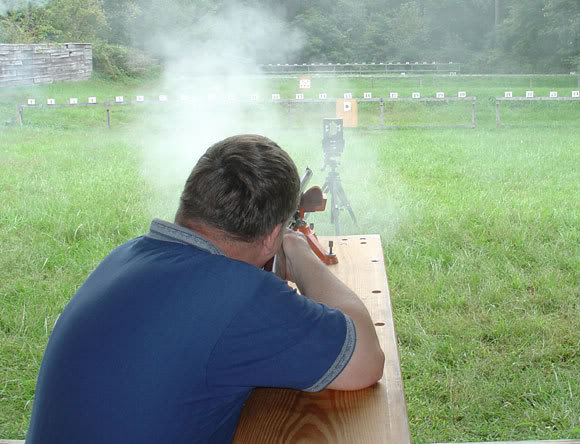We attempt to measure the effect of seating pressure on black powder ignition in both percussion and flintlock rifles. – Larry Pletcher and Steve Chapman
The purpose of these compression tests was to find out how flint and percussion rifles would react to changes in compression as the ball was seated on the powder. My personal method has been to use firm and consistent pressure whether I was shooting a percussion or a flint firearm. Many of my friends hold similar opinions. However I recently heard varying opinions and wanted to find a way to measure how different guns react to pressure changes.
I was pleased to have Steve Chapman, shown in the photos, help conduct these tests. Steve is a member of our local club and shoots at five other clubs. His shooting abilities eliminated variables that my shooting would have introduced. We also used his rifle which is convertible from flint to percussion. Having Steve and his rifle meant that all the gun handling was done by the same person, with the same rifle, and with the same equipment.
In order to load with identical seating pressures throughout a 5 shot group we adopted a method used by black powder cartridge shooters. We measured pressure not in pounds but in inches of compression. In our tests we used a stop on the ramrod that was set in the following 4 ways:
a. no compression
b. 1/16” of compression
c. 1/8” of compression
d. 3/16” of compression.
A collar was made with a set screw that could be firmly attached to a steel bench rod. This rod’s sole purpose was to seat the patched ball. The first setting was determined by seating a ball to just touch the powder. The collar was lowered 1/32 inch and attached. This left the ball “just a hair” above the powder. Each additional 5 shot group was loaded after adding a 1/16” shim between the muzzle and the collar and reattaching the collar.
The rifle was wiped with a wet and dry patch between shots. We were concerned that if the breech was not cleaned well, fouling would take up additional space, increasing the length of the powder charge, and alter the compression. We feel that thorough cleaning prevented this from happening.
We fired the rifle at 25 yards off a bench and through a chronograph. We recorded the velocities of each shot and noted those velocities on the targets as they were done. Our load was a .400 cast ball (Lyman mold) and pocket drill for patches. The patches were lubed with Murphys oil soap and cut at the muzzle. A powder charge of 40 grains of Goex fffg was used throughout all testing. After the velocity and ball placement on the target were recorded, a piece of black target paper was placed behind the target to improve the sight picture for the shooter. In effect the target was a fresh one for each shot. After firing the four groups in the flint gun, the vent liner was replaced with a percussion nipple and a mule ear percussion lock was installed. Then we repeated the four groups with percussion ignition.
Each 5 shot group was measured at the widest point and the width of the ball was subtracted to arrive at a center-to-center group size. The following chart shows the group sizes and the compression:
Compression —————– Flint —————- Percussion
- None ——————- .92 inch ————– .53 inch
- 1/16 inch —————.84 inch ————– .85 inch
- 1/8 inch —————–.85 inch ————– .55 inch
- 3/16 inch ————– .46 inch ————— .41 inch
Interpreting results can be tricky and should perhaps be left to the reader. My impression is that as a flintlock, the gun liked compression and responded to compression with smaller groups. The percussion version also liked compression but seemed a little more forgiving as far as the amount of compression used. The percussion shot far better with no compression, but when compression was added, both versions ended up essentially the same.
The obvious limitations of this test are that it was done on only one gun and only one powder brand. Will other guns or powder varieties respond the same way – only more testing will tell. Will this test change my loading? On flint guns the answer is probably yes. I will run more tests on my gun, but the seating pressure I normally use on my flint gun is too light based on this test.
Ideas for further tests might include:
- Pre-weighing powder charges on a scales
- Weighing and culling the balls
- Using aperture sights
- Attempt the test on a day with more consistent light conditions







Leave a Reply
You must be logged in to post a comment.